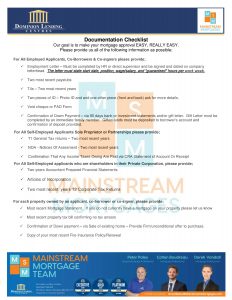
Mortgage Application Process & Required Documentation Explained
When a client is looking to get a pre-approval or doing a mortgage application for a home they just purchased the process is almost the same. Derek, Colten and I follow the same steps.
1). Get the application – The client will generally fill out our online application or meet with us in person. We collect their Names, Address, Birth Date, SIN#, Address History, Employment History, Assets & Liabilities.
2). Consent & Credit Check: We have the client sign a consent form. This allows us to check their credit and communicate their information to the lender of choice and keep their REALTOR and Lawyer informed along the process. We verify the credit score, typically we like to see a score of 620 or higher for an insured mortgage. We make sure that all payments are paid as agreed, that all credit facilities are under their limit and that any collections, judgements or other debts are paid as agreed and are reporting correctly on the client’s credit bureau.
3). Income Documentation: For employed clients we always request a letter of employment confirming the client’s start date, positions, wage/salary and GUARANTEED hours per week worked. The letter has to be on company letterhead. The letter is typically valid from 60 day from the day of issue. We will always request the clients two most recent paystubs. We verify and cross reference the information on the employment letter with the paystubs. We confirm the hours worked, the wage or salary and the year-to-date income. In some cases we will also request the two most recent years T4s. This would be to confirm overtime income or part time not guaranteed hours (we can take the lower of the most recent year or an average of the two years whichever is lower).
For self employed clients we will request the two most recent year T1 General Full Tax Returns *all pages* as well as the corresponding Notices of Assessment. We must also confirm that any income taxes owing are paid in full. If incorporated, we will require two years Accountant Prepared Financial statements (notice to reader), two years T2 Corporate tax returns and articles of incorporation and a corporate search.
4). Secondary Income Documentation: This type of income is usually Canada Child Benefit or Spousal support. For Canada Child Benefit we will request the children’s birth certificates, CCB statement and 3 months bank statements confirming the CCB deposits. For Spousal support, we will request the fully executed and notarized separation agreement and 3 months bank statements to confirm the amount deposited.
5). Down Payment Documentation: We will request 90 day bank history from any savings account, TFSA or RRSP. We verify account ownership and look for any large deposits made within the 90 day period. Typically any deposits over $2,500.00 will need to be verified or have to seed for an additional 90 days. For gifted funds we will request a gift letter from an immediate family member and confirmation of the gifted funds deposited into the client’s account. For Flex-down Mortgages, we will require a copy of the loan or credit facility used and that the funds have been deposited in the client’s account. For down payments coming from the sale of an existing home, we will require FIRM Offer to purchase, existing mortgage statement, & most recent property tax bill.
6). Existing Properties Not Being Sold – We will require and existing mortgage statement or title search and property tax bill.
The mortgage application process is simple. There is a lot of work that we have to do to make sure that the client’s are approved and won’t run into any snags. This is why we love working with our REALTORS who appreciate this process and want to make sure their clients have an amazing home buying experience.
7). Once we review all the documentation and information we perform our mortgage calculations and determine a maximum mortgage amount based on the amount of money the client is comfortable paying each month as well as a debt service ratio which typically needs to be under 44% for most borrowers. This ratio is a calculation of all of the client’s debt and housing payments divided by the clients eligible household income.
8). Once the pre-approval or approval is in place, it is very important that the clients maintain their credit standing, maintain their current employment as well as their current debt levels. This means that a client may not quit their job, change employers, buy any major purchases on credit as well as keep all their existing credit current and not miss any payments.
Please watch our video and like it on YouTube and refer to our “Documentation Checklist” for more information. Please feel free to share with your clients.
Click the link below for our YouTube video!
https://www.youtube.com/watch?v=aH3FJIIPHeE

